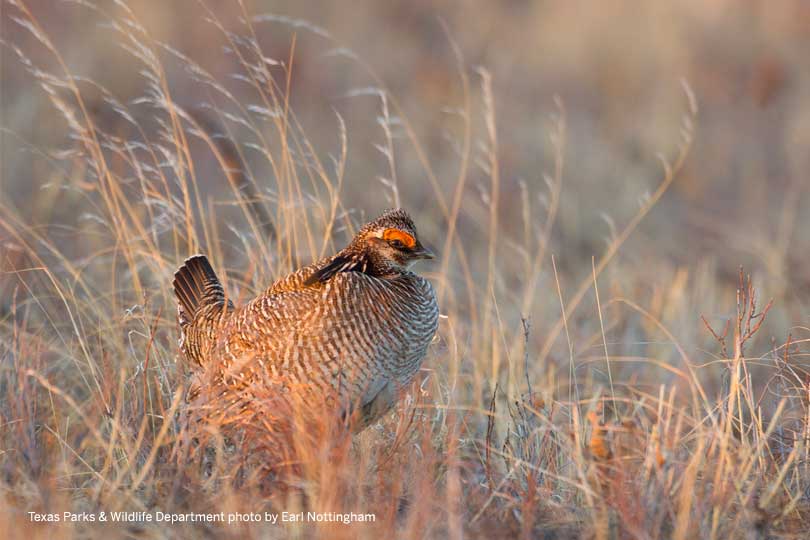By Julie Tomascik
Associate Editor
Improved habitat conditions and conservation efforts of farmers and ranchers is part of a strategy that has helped boost lesser prairie-chicken numbers.
And the U.S. Department of Agriculture’s (USDA) Natural Resources Conservation Service (NRCS) recently announced a three-year conservation plan—the Lesser Prairie-Chicken Initiative (LPCI)—to guide the voluntary restoration of 500,000 acres of habitat for the bird.
“Texas farmers and ranchers have been and are working to continually improve habitat for wildlife species, particularly the lesser prairie-chicken,” said Gene Richardson, Texas Farm Bureau director of Commodity and Regulatory Activities.
And agriculture has recently won a significant battle against the Obama administration. The Justice Department dropped its appeal of a judge’s ruling, which leaves the bird without protection from the Endangered Species Act (ESA).
“This demonstrates that voluntary conservation efforts of farmers and ranchers are working, and they can continue to operate without additional regulations that come with an ESA listing. Broad conservation at the ground level cannot happen in Texas without private landowners being a major factor,” Richardson said.
The iconic bird is found throughout short- and mid-grass prairies spanning five states—Texas, Colorado, Kansas, Oklahoma and New Mexico. To date, more than 1 million acres have been restored through the LPCI.
But there’s still room for growth in population.
It takes a working partnership between landowners and agencies to achieve that, especially as 95 percent of the species’ range is under private ownership, according to NRCS.
Threats to the bird include degraded rangeland health, invasive redcedar trees and mesquite, cultivation of grazing lands and lack of fire in grassland habitats.
LPCI’s science-based strategy, which aligns with other conservation partners, leverages farm bill conservation funds to help farmers and ranchers voluntarily enhance and restore habitat. Programs such as Environmental Quality Incentives Program (EQIP) and the Conservation Stewardship Program (CSP) provide technical and financial assistance to help landowners put conservation practices in place.
“The voluntary conservation efforts have paid off and the bird is no longer listed as a threatened species under the Endangered Species Act,” Richardson said. “That’s a win-win. Habitat is restored for the lesser prairie-chicken and the long-term productivity and resiliency of grasslands is improved.”
The devastating drought conditions that gripped the chicken’s habitat, and the Lone Star State, aren’t forgotten. Streams ran dry. Pastures withered. And wildlife populations—including the lesser prairie-chicken—dwindled as years of soaring temperatures and lack of rainfall took their toll.
But, with the conservation efforts under the LPCI, an aerial survey conducted last year by the Western Association of Fish and Wildlife Agencies estimated a 25 percent increase in the bird’s numbers over 2014. And the year prior saw a 20 percent increase.
The two consecutive year increases in population growth shows the grassroots efforts are working, Richardson noted.
“NRCS remains firmly committed to promoting and delivering long-term conservation of the working grassland ecosystems that the species requires,” said Salvador Salinas, NRCS state conservationist in Texas. “Across the country, we’re seeing firsthand how farmers, ranchers and forest landowners are voluntarily stepping forward to aid wildlife species.”

